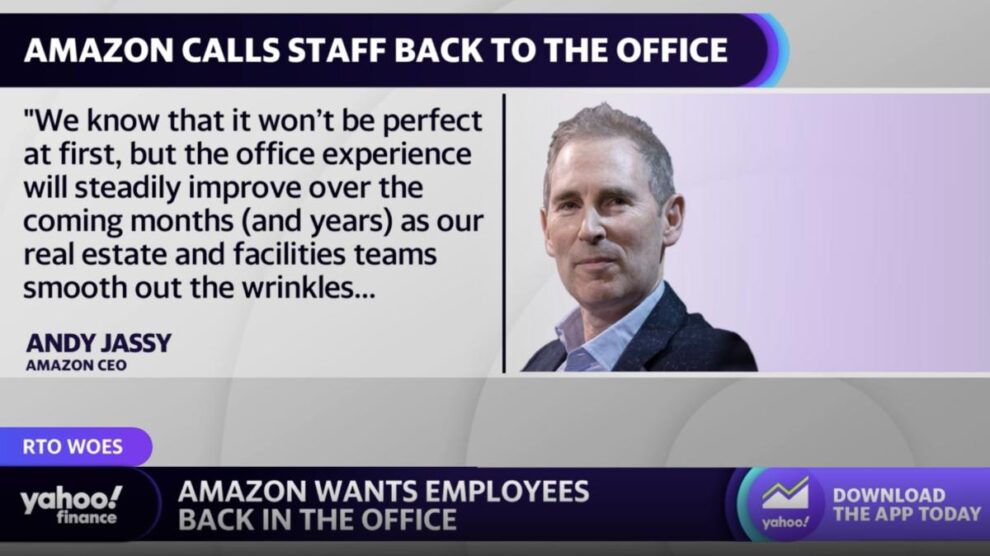Yahoo Finance Live co-hosts Seana Smith and Dave Briggs examines office occupancy rates and the state of work-from-home trends as tech companies like Amazon have begun demanding employees return to the office.
Video Transcript
DAVE BRIGGS: The long, slow creep back to the office continues today with Amazon boss Andy Jassy. He’s the latest to say it’s time to return, telling employees under a new policy they’ll need to be in the office at least three days a week starting on May 1. Jassy writing in a memo available online, quote, “we know that it won’t be perfect at first, but the office experience will steadily improve over the coming months and years as our real estate and facilities teams smooth out the wrinkles and ultimately keep evolving how we want our offices to be set up to capture the new ways we want to work.”
The 10 city average office occupancy was 48.6% for the most recent week. That’s according to Kastle Systems, who tracks badge swipes. On the low end, you’ll see San Jose tech workers just over 40% back, while workers in Houston, Texas are north of 60%. We talked to “Shark Tank” investor and Corcoran Group founder Barbara Corcoran this week about where the power lies in the RTO dynamic.
BARBARA CORCORAN: My advice would be more to the employer, the boss. The fact of the matter is they’re not in charge anymore. The employees are. And the quicker they realize that, the better they are going to be able to run their businesses. Even when they offer free dinners and lunches at parties, people still aren’t coming in. And when foot traffic is down, people don’t go to the restaurants. They don’t go to the bars after work. The whole economy suffers.
DAVE BRIGGS: And the whole economy has suffered here in New York City and in particular out west. I mentioned San Jose. San Francisco, that area really suffering from lack of return to office. But the question is what she pointed to there, Seana. Is the power really in the worker’s hands? It feels like slowly bosses are pulling back on that.
SEANA SMITH: It does. But when you take a look at the numbers and how resilient the jobs market is, how strong the jobs market is, how the hiring continues to outpace or really be much stronger than we ever anticipated it to be, at this point, with rates so high, I have to say the power is still with the worker. And we’re seeing it in the quit rates. Last year, over 50 million people quit their job. 4.1 million quit their job in December alone.
So, yes, it is tapering off just a little bit. But still, those quit rates remain very, very high. So I think the power is in the worker. It will be, once we get a little bit more details, lots of questions about how successful he’s going to be at getting workers back into the office because take a look at Twitter, for example. Elon Musk. I’m not comparing the two. Two very different cultures, at least at this point. But still, Elon Musk was met with a lot of resistance, given the fact that the tech industry overall has been pretty flexible in terms of where and how their employees can work from.
DAVE BRIGGS: Yeah. And we heard a big complaint at Apple when the word was that Tim Cook was going to pull them back. Three days a week sounds pretty reasonable I think for most of us. I wonder if it’s going to have a different power dynamic in different industries. And we talk about tech because we’re talking about Andy Jassy and Amazon who laid off, what, 18,000 workers late last year.
And we’ve seen most of the layoffs concentrated in the tech sector. So perhaps that’s one industry where bosses, CEOs feel comfortable pulling back employees because they know there might be looming layoffs. Maybe they feel compelled to listen to their boss. I do like what Barbara Corcoran was saying about make that experience more enjoyable. Employ a little bit of fun around the office. Give them a reason to come in, not just simply an order.
SEANA SMITH: Yeah. And there certainly is a huge argument and a strong argument I think to get your employees back to the office. Just think about us as a team. We’re sitting around each other. You’re talking. You’re generating ideas. An environment that you certainly would not have when everyone is home. So, yes, I think the hybrid situation is the best case scenario situation.
It would be great if we only had to come into the office three days a week. We’re here five days a week. But I think the hybrid situation is what most workers prefer. We’ve seen it survey after survey. So we’ll see whether or not three days might be a little bit too much for Amazon workers. But, certainly, the labor market– the competition’s out there. So if they want to go somewhere else, they might have a different company that’s waiting to hire them.
DAVE BRIGGS: Indeed.






